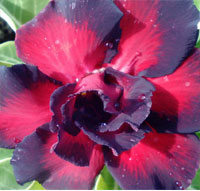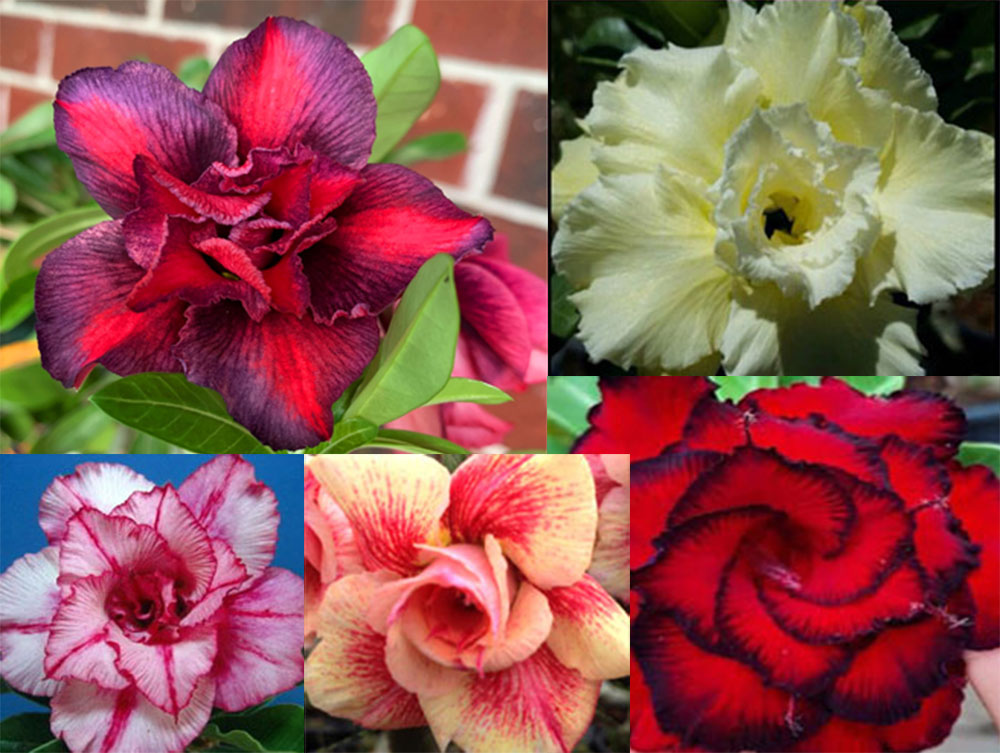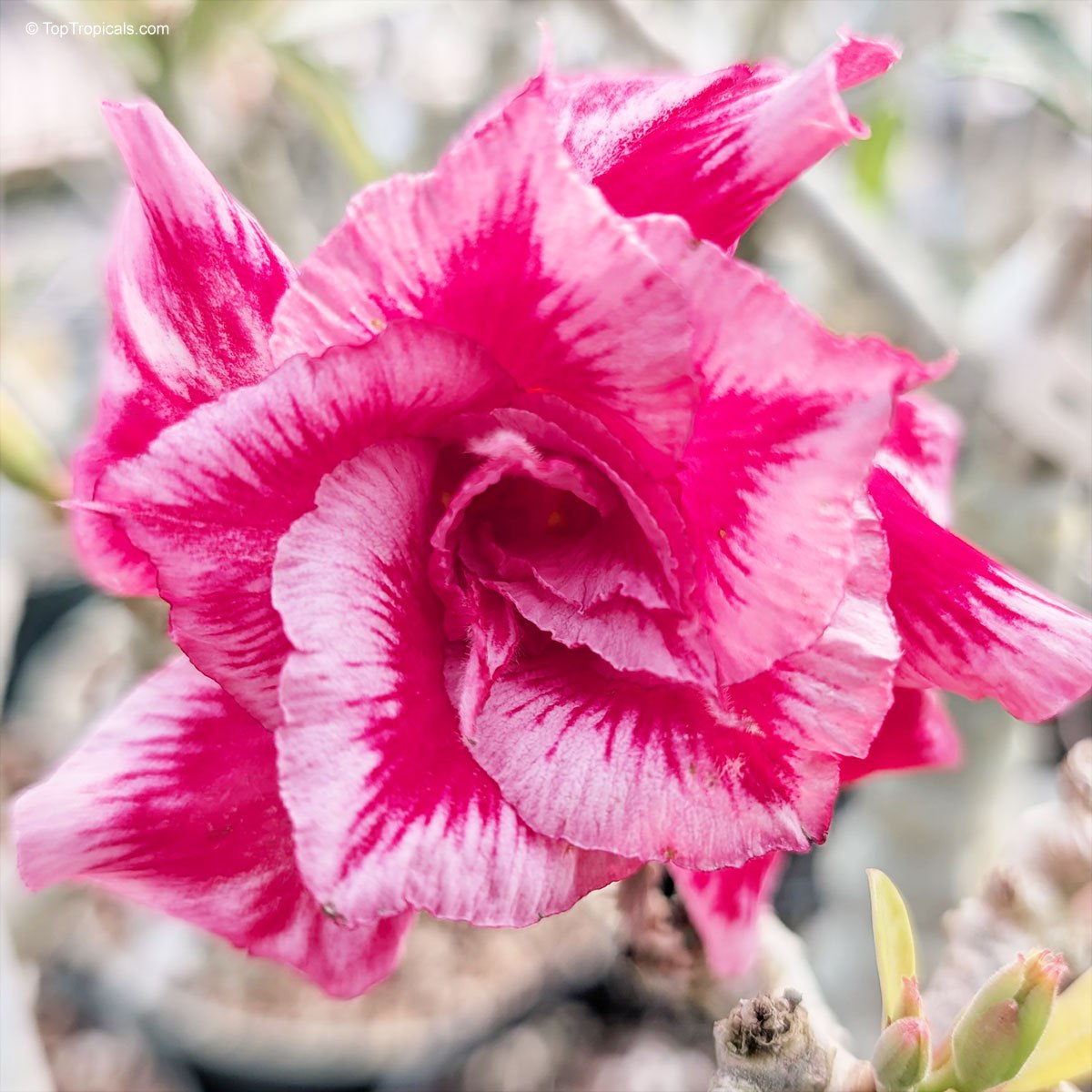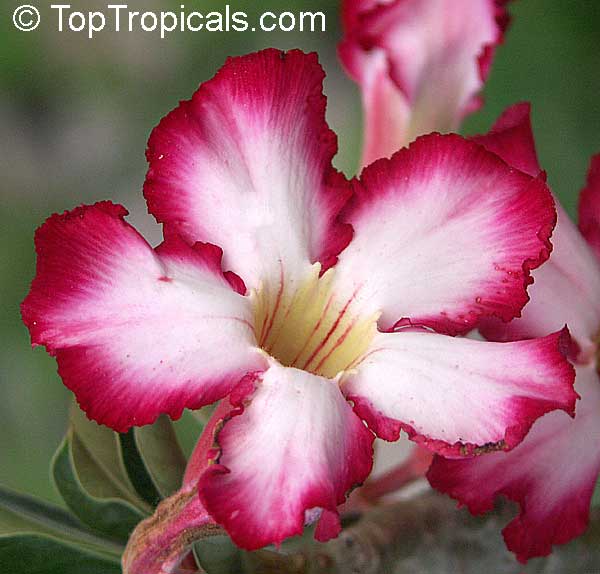Date: 27 Feb 2022
New Exotic Adeniums
Saving on your favorite plants is Easy.
Easy like Sunday Morning...
It's time for our favorite day and another Easy stroll through Top Tropicals Garden with savings of
up to 50% and MORE!
The Flower of Prosperity and Good Fortune...
The Adenium obesum, Desert Rose, is a highly prized ornamental plant, perceived in some cultures as a sacred symbol of prosperity, abundance and good fortune. Since the Desert Rose is strong and adaptable to climatic conditions, it represents strength, persistence and resilience. We could all use a little more of these qualities in our lives...
Adeniums (Desert Roses) are the easiest plants in cultivation yet they bring you so much joy with their colorful flowers and showy caudex. There are hundreds, if not thousands of amazing colors and new hybrids are created every year. Many gardeners want to collect them all! And we can help you to grow your collection. We have many new varieties in stock and are offering two special Collection Deals!
Special Deals for Desert Rose Collectors
The plants are well developed, with large caudex, grown
in 1 gal pots, normally $42.95 each,
with Collection savings of $30 and $65!
3 Adeniums Collection
Regularly $128.95,
Collection price $98.95 - savings of $30 per set!
Varieties included in this collection:
RED Adenium Red Wine
WHITE Adenium Jasmine
BLACK Adenium Black Widow
5 Adeniums Collection
Regularly $214.95,
Collection price $149.95 - savings of $65 per set!
Varieties included in this collection:
PURPLE Adenium Mee Stang
LIGHT YELLOW Adenium Yellow Gold (Vanilla Gold)
STRIPED PINK Adenium Bua Champoo
ORANGE Adenium Yellow Gift (Sai Thong)
RED-BLACK Adenium Red Dragon
Now wait... Save even more with Easy Sunday:
Combine both collections and save ANOTHER $15! Use this limited time offer coupon:
ADENIUM15
Remember, this Easy Sunday Deal expires on Tuesday 3-1-22!
Date: 20 Jun 2025
Adenium Rainbow, Part 1
Adenium varieties
Now, in June, they have more and more blooms! We are sharing these amazing colors with you.
To be continued, check back soon!⤵️
· Easy to grow indoors or out
- · Thrive in sun, shade, and low humidity
- · Drought-tolerant, low maintenance
- · Not picky about soil
- · Stunning blooms and unique caudex shapes
- 🌸 How Many Varieties Exist?
· Over 200 hybrids at Top Tropicals
- · 100+ varieties in stock now
- · From doubles to red, purple, yellow, striped, dotted, rainbow, even black flowers - you'll want them all!
🌸 How to Grow a Big, Swollen Caudex - a simple trick with big results:
Each time you repot, raise the plant slightly to expose more of the upper roots. This encourages new root growth downward and helps form a thicker, more dramatic caudex.
- · Use a well-draining mix
- · Water only when dry - Adeniums love dry conditions
- · Feed with Sunshine Megaflor Booster that supports both caudex and blooms
- · Grow best in filtered bright light
📚 More about Adeniums:
- • More posts about #Adenium
- • The First Video of Exotic Adenium Hybrids
- • Why Adeniums are the most popular container plants
- • How to grow a happy Adenium
- • What is the easiest container plant with beautiful flowers
- • Multi-grafted Adenium with different colors of flowers on the same plant
- • What you need for successful growing Adeniums
🛒 Shop Adenium colors and hybrids
#Container_Garden #How_to #Shade_Garden #Adenium
🟢 Join 👉 TopTropicals
Date: 21 Apr 2025
The First Video of Exotic Adenium Hybrids!
Exotic Adenium Hybrids
- 🌸
· Easy to grow indoors or out
- · Thrive in sun, shade, and low humidity
- · Drought-tolerant, low maintenance
- · Not picky about soil
- · Stunning blooms and unique caudex shapes
- 🌸 How Many Varieties Exist?
· Over 200 hybrids at Top Tropicals
- · 100+ varieties in stock now
- · From doubles to red, purple, yellow, striped, dotted, rainbow, even black flowers - you'll want them all!
🌸 How to Grow a Big, Swollen Caudex
Each time you repot, raise the plant slightly to expose more of the upper roots. This encourages new root growth downward and helps form a thicker, more dramatic caudex.
- · Use a well-draining mix
- · Water only when dry - Adeniums love dry conditions
- · Feed with Sunshine Megaflor Booster that supports both caudex and blooms
- · Grow best in filtered bright light
👍 A simple trick with big results!
📚 More about Adeniums:
- • Why Adeniums are the most popular container plants
- • How to grow a happy Adenium
- • What is the easiest container plant with beautiful flowers
- • Multi-grafted Adenium with different colors of flowers on the same plant
- • What you need for successful growing Adeniums
🛒 Shop Adenium colors and hybrids
#Container_Garden #How_to #Shade_Garden #Adenium
🔴 Join 👉 TopTropicals
Date: 30 May 2025
Adenium Xmas Santa - the jolliest bloom
📸 Photo of Adenium Xmas Santa for the previous post 👆
🛒 Shop adeniums
#Nature_Wonders #Container_Garden #Adenium
🟢 Join 👉 TopTropicals
Adenium sp.
Family:Apocynaceae
Adenium, Desert Rose, Impala Lily
See other exotic species of Adenium, photo gallery of exotic varieties and Thai Adeniums - milti-colored, multi-grafted.
See article about Adenium.
Adenium sp.
Family:Apocynaceae
Desert Rose, Impala Lily, Adenium hybrids
Exotic species of Adenium: Adenium swazicum, Adenium somalense, Adenium arabicum, Adenium boehmianum, Adenium multiflorum, Adenium crispum, Adenium obesum. Adeniums have many spectacular hybrids. The basic culture is very similar to orchids. A small pot with excellent drainage is a must. Adeniums do not like both over-watering or drying-out. There is a little secret of how to create a weird shape... more
See photo gallery of exotic varieties and Thai Adeniums - milti-colored, multi-grafted.
See article about Adenium.
Close window
Adenium arabicum
Family:Apocynaceae
Desert Rose
Growing to a height of about 4-5ft, this succulent plant is a member of the same family as Plumeria. Its swollen, often twisted trunk is pale gray. The leaves are glossy and club-shaped, and the flowers, which appear almost continuously, are trumpet-shaped, and range from white and bright pink to crimson red. It exudes a highly toxic sap which in some places is used as a poison for arrows. Adenium is not generally grown in moist tropical gardens but is often seen as a decorative pot plant; it may also be used in rock gardens. It needs full sun and a well-drained potting mixture. Exotic multi-color varieties can be grafted on the same plant. See other exotic species of Adenium, photo gallery of exotic varieties and Thai Adeniums - milti-colored, multi-grafted. More info about Adenium
Adenium boehmianum
Family:Apocynaceae
Desert Rose
Growing to a height of about 4-5ft, this succulent plant is a member of the same family as Plumeria. Its swollen, often twisted trunk, is pale grey. The leaves are glossy, and club-shaped and the flowers, which appear almost continuously, are trumpet-shaped and range from white and bright pink to crimson red. It exudes a highly toxic sap that in some places,is used as a poison for arrows. Adenium is not generally grown in moist tropical gardens but is often seen as a decorative pot plant; it may also be used in rock gardens. It needs full sun and a well-drained potting mixture. Exotic multi-color varieties can be grafted on the same plant. See other exotic species of Adenium, photo gallery of exotic varieties and Thai Adeniums - milti-colored, multi-grafted. More info about Adenium
Adenium multiflorum
Family:Apocynaceae
Desert Rose
Growing to a height of about 4-5ft, this succulent plant is a member of the same family as Plumeria. Its swollen, often twisted trunk, is pale grey. The leaves are glossy and club-shaped. The flowers appear almost continuously, are trumpet-shaped, and range from white and bright pink to crimson red. It emits a highly toxic sap which in some places is used as a poison for arrows. Adeniums are not generally grown in moist tropical gardens but are often seen as a decorative pot plant; they may also be used in rock gardens. They need full sun and a well-drained potting mixture. Exotic multi-color varieties can be grafted onto the same plant. See other exotic species of Adenium, photo gallery of exotic varieties and Thai Adeniums - milti-colored, multi-grafted.
See article about Adenium.
Adenium obesum
Family:Apocynaceae
Desert Rose, Impala Lily
Growing to a height of about 4-5ft, this succulent plant is a member of the same family as Plumeria. Its swollen, often twisted trunk, is pale grey. The leaves are glossy, and club-shaped. The flowers appear almost continuously, are trumpet-shaped and range from white and bright pink to crimson, red. It exudes a highly toxic sap, which in some places is used as a poison for arrows. Adeniums are not generally grown in moist tropical gardens but are often seen as a decorative pot plants. They may also be used in rock gardens.They need full sun and a well-drained potting mixture. Exotic multi-color varieties can be grafted onto the same plant. See other exotic species of Adenium, photo gallery of exotic varieties and Thai Adeniums - milti-colored, multi-grafted.
See article about Adenium.
Adenium somalense
Family:Apocynaceae
Desert Rose
Growing to a height of about 4-5ft, this succulent plant is a member of the same family as Plumeria. Its swollen, often twisted trunk is pale grey, the leaves are glossy and club-shaped, and the flowers, which appear almost continuously, are trumpet-shaped and range from white and bright pink to crimson, red. It exudes a highly toxic sap which in some places is used as a poison for arrows. Adenium is not generally grown in moist tropical gardens but is often seen as a decorative pot plant; it may also be used in rock gardens. It needs full sun and a well-drained potting mixture. Exotic multi-color varieties can be grafted on the same plant. See other exotic species of Adenium, photo gallery of exotic varieties and Thai Adeniums - milti-colored, multi-grafted.
See article about Adenium.
Detailed plant profiles: 121 plants found












































